Marine aquariums require special lighting if you wish to keep corals.
Corals contain zooxanthellae, a kind of algae, that photosynthesizes light into food and oxygen for itself and for the coral… but not just any light… they require a particular spectrum of light…
While this is a complex subject and can be overwhelming for beginners, our marine aquarium lighting guide provides you with all the information you need.
Table of Contents
Top 5 Marine Aquarium LED Lighting Products
| # | Preview | Product | Quick Review |
| 1 | 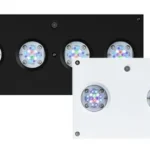 | AI Hydra 32HD / 64HD Marine LED Lighting Units | Best Overall |
| 2 | 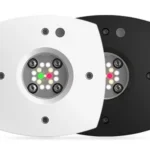 | AI Prime 16HD Marine LED Lighting Unit | Best For Nano Tanks |
| 3 | 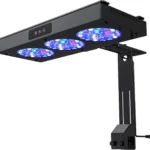 | NICREW Aquarium LED Reef Light | Budget Option |
| 4 | 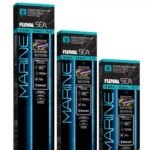 | Fluval Sea Marine 3.0 LED | Fish-only tanks and soft corals |
| 5 | 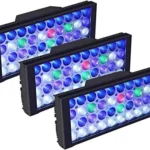 | PopBloom LED Marine Aquarium Lights | Cheap for a reason |
Best Light Spectrum for a Marine Aquarium
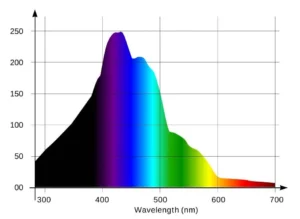
The graph shows the penetration depth of solar light into seawater, depending on wavelength.
As you can see, colours in the wavelengths between 370 and 500 nm (violet and blue) penetrate farthest, whereas green light has less penetration, yellow and orange even less, and red only in the shallowest water.
Over millennia, corals (and their zooxanthellae) have evolved to take advantage of the light most available to them and that’s what we try to replicate in our marine aquariums.
There are of course some corals that do not photosynthesize and can live at great depths but these are rarely found in home marine aquariums.
Types of Marine Aquarium Lighting
Metal Halide Lighting – Only really found now in commercial set-ups to propagate corals, metal halide lights are very bright but they have a high power consumption and can get very hot and are now rarely found in hobbyist aquariums.
T5 Lighting – Once the standard for home marine aquariums, T5 lights are fluorescent tubes that offer great light coverage over your tank and use much less power than metal halide lights. The colour spectrum is controlled by using different coloured bulbs.
However, their advantages on power usage and controllability has now been largely superseded by modern LED lighting. That said, many reef keepers still use them in a hybrid system with a combination of T5 tubes and LED lights for greater coverage.
LED Lighting – 90% of reef keepers now use LED lighting over their marine aquariums. Whilst the good ones are more expensive than traditional lighting methods, they offer far greater control, use far less power and produce very little excess heat.
Why You Should Use Marine Aquarium LED Lighting
Marine LED lighting is now the standard for reef aquariums and it’s not hard to see why.
Marine Aquarium LED Lighting has a much lower power consumption than T5 tubes or metal halide lights meaning lower electricity bills and a reduced carbon footprint.
They also have a much longer lifespan. With T5 tubes or metal halide bulbs you’d probably need to replace them every 6 months or so, whereas LED lights should last for years if looked after properly, again meaning less cost and waste.
Perhaps the biggest advantage of Marine LED lights, though, is their controllability.
Whilst some will only allow limited control, such as dimming, the better ones can be controlled via an App allowing infinite control over the colour spectrum and lighting schedule.
PAR Level For Marine LED Lighting

You will probably by now have heard of the PAR level when talking about marine aquarium lighting. But what is it?
PAR stands for Photosynthetic Available Radiation and is the amount or intensity of light that is in the proper spectrum for corals to utilize.
Generally, different corals do better at different PAR levels as follows:-
- Soft Corals (zoanthids, mushrooms and leathers, etc.) : 50-150 PAR
- LPS Corals (torches, hammers, etc.) : 50-200 PAR
- SPS Corals (Stylophora, Acropora, etc.) : 200-500 PAR
Par will be higher closer to the surface of your marine aquarium as that is also closer to the lights. Likewise, the PAR level will be lower on the sandbed and the edges of your tank furthest from your lights.
So, in general, you should place SPS corals towards the highest point in your marine aquarium with LPS and soft corals lower down.
You can purchase a PAR meter, though they are not cheap, or you may be able to rent one from your local fish store to test the PAR level in your tank.
However, you may find it easier to check out the BRStv videos on YouTube. Simply search for the light you are considering and check out their detailed review which will give the PAR levels you can expect.
Top 5 Marine Aquarium LED Lighting Product Reviews
Here are my reviews of the best Marine Aquarium LED Lighting products:-
1. AI Hydra 32HD / 64HD Marine LED Lighting Units
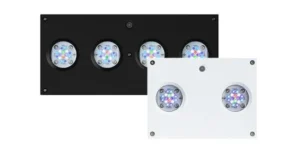
The AI Hydra 32 and 64HDs are the flagship marine LED lights from Aqua Illumination, replacing the previous 26 and 52HDs
Both lights have clusters (or pucks) of 16 LEDs under each lens, with the 32HD having 2 pucks and the 64HD having 4.
The make-up of the LED colours of each puck (see illustration above) allows for the full Corallab AB+ light spectrum closely mimicking solar light penetration into seawater.
Maximum power consumption is 90W for the 32HD and 135W for the 64HD.
The lights are controlled using the free myAI app via Bluetooth on any smartphone. Allows for individual control of 8 colour bands, 24-hour scheduling, on/off and feed mode.
AI does not supply any pre-set colour settings though these can easily be found and downloaded from Facebook groups and forums.
We’d recommend Two Hydra 32HDs for tanks between 90 – 120 inches in length, and 24 inches deep. For larger tanks, add more or consider using the 64HD. For SPS intensive tanks the 64HD will provide greater coverage and depth.
Mounting kits and arms are purchased separately.
Pros
- Bluetooth Control
- Full 8 band spectrum control
- 24-hour Scheduling
- Feed Mode
- Acclimatisation Mode
- Save and load pre-sets
Cons
- Mounting arms purchased separately
2. AI Prime 16HD Marine LED Lighting Unit
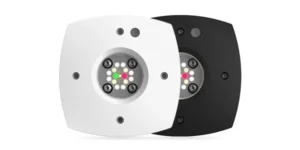
The AI Prime 16HD is essentially the same as the Hydra except it has just one lense cluster (or puck) of 16 LEDs making it ideal for smaller nano tanks up to 60 inches in length, and 24 inches deep.
For larger tanks, you can add additional 16HDs but for tanks larger than 90 inches (length) or for SPS corals, the Hydra 32HD or 64HD are the better bet.
Pros
- Great for Nano Tanks
- + See Hydra above
Cons
- Mounting arms purchased separately
3. NICREW Aquarium LED Reef Light
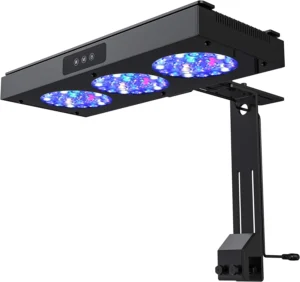
The Nicrew HyperReef LED lights come in four sizes for various tank sizes.
| HyperReef 30 | HyperReef 50 | HyperReef 100 | HyperReef 150 | |
| Watts | 30 | 50 | 100 | 150 |
| LEDs | 18 | 24 | 48 | 72 |
| Par | 58 | 128 | 250 | 305 |
| Spread | 50 x 50cm | 60 x 60cm | 60 x 60cm | 75 x 75cm |
Full spectrum light that you can manually adjust the blue and white channels to 5%, 20%, 40%, 60%, 80% and100% intensities.
The HyperReef Light Controller can be purchased separately to control both the channels and timer settings.
Pros
- Good price
- Independent control of blue and white channels
- Dimmable
Cons
- Power hungry
- Manual control
- HyperReef Light Controller purchased separately
- Tank mount purchased separately
4. Fluval Sea Marine 3.0 LED
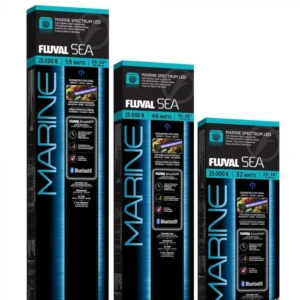
The Fluval Sea Marine 3.0 LED lights are the next-gen marine aquarium lights from the trusted brand, Fluval.
They come in three sizes to cover tanks up to 4 feet in length.
- Fluval Sea Marine 3.0 LED 32w (24” – 34”)
- Fluval Sea Marine 3.0 LED 46w (36” – 48”)
- Fluval Sea Marine 3.0 LED 59w (45” – 57”)
Controlled by the FluvalSmart App on your phone, you can use one of three pre-set ‘habitats’, Sunny Reef, Deep Sea Glo or Colour Burst to get you started which is great for beginners.
Alternatively, you can independently control 7 unique band waves for full spectrum results.
Full 24-hour light cycle control allows you to gradually increase and decrease lighting power to mimic sunrise, sunset and nighttime.
Also comes with a manual on, off or blue-only touch switch.
Pros
- Bluetooth Control
- Easy to use
- 24-hour Scheduling
- Pre-set habitats
- 7 unique band waves for full spectrum control
- Good for beginners or fish-only tanks
- 3-year warranty
Cons
- Low PAR at depths more than 12″
- Undemanding corals only
5. PopBloom LED Marine Aquarium Lights
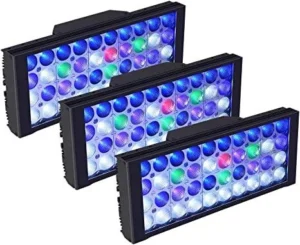
We’ve included these lights as an example of the Chinese ‘black-box’ marine aquarium lights which you will find on many places online.
They are cheap and you will no doubt hear stories of people who have successfully grown corals with them. However, whilst that may be the case, it’s unlikely that these lights will be the best for your tank in either the short or long term.
They have virtually no control over the colour spectrum or schedule, are prone to overheating, and usually break within a few months. Buy cheap, buy twice. Avoid!
Pros
- Cheap
- Dimmable
Cons
- Cheap
- Potentially dangerous
- No control over colour spectrum or schedule
- Low PAR
- Frequently break down
Conclusion
If you want to keep corals you’ll need great lighting for your marine aquarium and that means Smart LED marine lights.
Our best overall pick is the AI Hydra series which have all the power you’ll need, full spectrum control, great coverage and an intuitive and easy-to-use app.
For smaller nano tanks the AI Prime is the best bet and for fish-only aquariums, the Fluval Sea Marine 3.0 is more than adequate.
If you are on a tight budget, the Nicrew HyperReef LED lights are a decent option but they lack full control and use more power than the comparable AI Prime and Hydras.
Marine Aquarium LED Lighting FAQs
What is the best lighting for coral growth? – Full spectrum marine aquarium led lighting offers the best option for coral growth. Corals need lights that produce a particular spectrum of mainly blue and violet for optimum growth.
What settings should I use for my marine aquarium LED lights? The settings will vary depending on the lights and you should closely follow any instructions given.
However, unfortunately, detailed settings as to how you should set each colour spectrum are rarely given.
You can find out what others are using on forums or Facebook groups but we’d recommend checking out the relevant BRStv video on YouTube.
Do corals need light at night? Not really. In the wild, of course, there will be moonlight on many nights but it is extremely weak compared to sunlight.
Some LED marine lights provide a moonlight option but we think this is more of a gimmick. We set our lights to be completely off for 12 hours at nighttime.
How many hours of light do corals need? A good schedule to run would be between 9 – 12 hours. If your light has the functionality, use a one hour ramp-up time at the start and a similar ramp-down time at the finish to replicate sunrise and sunset.
How much par do I need for corals? – Generally, different corals do better at different PAR levels as follows:-
- Soft Corals (zoanthids, mushrooms and leathers, etc.) : 50-150 PAR
- LPS Corals (torches, hammers, etc.) : 50-200 PAR
- SPS Corals (Stylophora, Acropora, etc.) : 200-500 PAR
How do you know if coral needs more or less light? – If corals close to the surface begin bleaching and turning white you have almost certainly got too much light. If corals fail to grow or lack colour then you may have too little light or light of the wrong spectrum.
Does a fish-only saltwater tank require special lighting? No. You can use just about any aquarium lighting. Most people, though, still prefer the ‘blue look’ that marine aquarium lighting offers.
We’d recommend the Fluval Sea Marine 3.0 LED lights reviewed above for fish only tanks.
